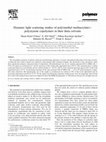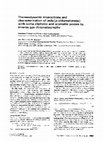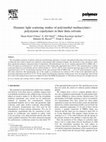Papers by Bahattin Baysal
Journal of Polymer Science Part C: Polymer Symposia, 1963
An inverse suspension polymerization method for the preparation of thermoresponsive hydrogel micr... more An inverse suspension polymerization method for the preparation of thermoresponsive hydrogel microspheres based on N-isopropylacrylamide was de- scribed in this article. The polymerization reaction was car- ried out at 200 rpm stirring rate and the microspheres ob- tained were in the size range of 71-500 m in the swollen states. The particles were sieved by using ASTM sieves. The selected

The coil-globule transitions of random (statistical) and alternating copolymers of styrene and me... more The coil-globule transitions of random (statistical) and alternating copolymers of styrene and methyl methacrylate in their theta solvents, cyclohexanol and 2-ethoxy ethanol were studied by using dynamic light scattering technique. The dimensions of the copolymeric chains show smooth and continous contractions below u temperatures. The hydrodynamic size, R h , of a random copolymer P(St-co-MMA) M w 4:59 £ 10 6 g=mol in cyclohexanol u 68:68C decreases to 48% of that in the unperturbed state at 56.58C. This copolymer shows a similar contraction behavior in a second theta solvent 2-ethoxy ethanol u 58:48C: The R h of this copolymer decreases again to 48% of that in the unperturbed state at 45.38C. An alternating copolymer of the same monomers P(St-alt-MMA) M w 2:62 £ 10 6 g=mol displayed a comparable chain contraction. The hydrodynamic size of this sample in cyclohexanol was reduced to 59% of that in the unperturbed state by decreasing temperature from 60.8 to 53.38C. For the random and alternating copolymers studied in this work, the temperature interval from the u-state to the collapsed state is narrower compared to that of the PMMA homopolymer. q
International Journal of Pharmaceutics, 2004
N-isopropylacrylamide/itaconic acid copolymeric hydrogels were prepared by irradiation of the ter... more N-isopropylacrylamide/itaconic acid copolymeric hydrogels were prepared by irradiation of the ternary mixtures of Nisopropylacrylamide/itaconic acid/water by ␥-rays at ambient temperature. The effect of comonomer concentration, irradiation dose and pH on the swelling equilibria were studied. Lidocaine was used as a model drug for the investigation of drug release behaviour of hydrogels. Lidocaine adsorption capacity of the hydrogels were found to increase from 3.6 to 862.1 (mg lidocaine/g dry gel) with increasing amount of itaconic acid in the gel structure. Adsorption and release processes were followed at 4 and 37 • C, respectively. The release studies showed that the basic parameters affecting the drug release behaviour of the hydrogels were pH and temperature of the solution and cross-link density of the gels.
Polymer Gels and Networks, 1997
Polymer Bulletin, 1989
Acrylonitrile was polymerized by an insertion process on being added to solutions containing the ... more Acrylonitrile was polymerized by an insertion process on being added to solutions containing the adduct of the reaction of tetrakis(dimethylamino) titanium (T4)and azobisisobutyronitrile (AIBN) .The obtained azo-linked polyacrylonitrile has appropriate initiating functionality for a subsequent vinyl polymerization.

Polymer, 1992
Some thermodynamic quantities were obtained for the interactions of poly (p-chlorostyrene) with n... more Some thermodynamic quantities were obtained for the interactions of poly (p-chlorostyrene) with n-pentane, n-hexane, n-heptane, benzene, toluene, isopropylbenzene and n-propylbenzene by the inverse gas chromatography method in the temperature range 150-170°C. The specific retention volumes ( V~g ), weight fraction activity coefficients of solute probes at infinite dilution (l'~), Flory-Huggins thermodynamic interaction parameters (X ~2 ), interaction parameters based on hard-core volumes (Z*2), effective exchange interaction parameters (X12) of the equation of state theory, between polymer and solutes are given. The molar enthalpy of sorption (A/4s), the partial molar heat of mixing at infinite dilution (A/7~:) and the solubility parameter of polymer (32) were also calculated. (Keywords: poly(p-chlorostyrene); inverse gas chromatography; polymer-solvent interactions; equation of state parameters) 0032-3861/92/2145634)6 ~V 1992 Butterworth Heinemann Ltd. POLYMER, 1 992, Volume 33, Number 21 4563 Study of poly( p-chlorostyrene ) by inverse gas chromatography: F. Ydmaz et al. I ' I J J J J I ] t I J J
Polymer, 1986
Block copolymers of poly(styrene-b-methyl methacrylate), poly(styrene-b-n-butyl methacrylate) and... more Block copolymers of poly(styrene-b-methyl methacrylate), poly(styrene-b-n-butyl methacrylate) and poly(methyl methacrylate-b-styrene) have been prepared via chemical reactions. A new polymeric peroxycarbamate is synthesized by reacting equimolar amounts of an aliphatic diisocyanate with a dihydroperoxide. This compound is an effective polymerization initiator, and is used to prepare active prepolymers containing fragments of polymeric peroxycarbamate. A second vinyl monomer is then incorporated to produce various block copolymers. Styrene contents, intrinsic viscosities and chemical and mechanical properties of the copolymers were determined.

Polymer, 2001
The coil-globule transitions of random (statistical) and alternating copolymers of styrene and me... more The coil-globule transitions of random (statistical) and alternating copolymers of styrene and methyl methacrylate in their theta solvents, cyclohexanol and 2-ethoxy ethanol were studied by using dynamic light scattering technique. The dimensions of the copolymeric chains show smooth and continous contractions below u temperatures. The hydrodynamic size, R h , of a random copolymer P(St-co-MMA) M w 4:59 £ 10 6 g=mol in cyclohexanol u 68:68C decreases to 48% of that in the unperturbed state at 56.58C. This copolymer shows a similar contraction behavior in a second theta solvent 2-ethoxy ethanol u 58:48C: The R h of this copolymer decreases again to 48% of that in the unperturbed state at 45.38C. An alternating copolymer of the same monomers P(St-alt-MMA) M w 2:62 £ 10 6 g=mol displayed a comparable chain contraction. The hydrodynamic size of this sample in cyclohexanol was reduced to 59% of that in the unperturbed state by decreasing temperature from 60.8 to 53.38C. For the random and alternating copolymers studied in this work, the temperature interval from the u-state to the collapsed state is narrower compared to that of the PMMA homopolymer. q
Polymer, 1993
... Interpenetrating polymer networks of poly(dimethylsiloxane): 1. Preparation and characterizat... more ... Interpenetrating polymer networks of poly(dimethylsiloxane): 1. Preparation and characterization E. Elif Hamurcu and Bahattin M. Baysal* Department of Chemical Engineering and ... They were dried at 70 C in a vacuum oven for 24 h. Two prepolymers, PDMS-15 and PDMS-75 ...
Polymer, 1997
... of polycaprolactone-poly( di met hylsi I oxa ne ) - po lyca p ro I a cto ne triblock copolyme... more ... of polycaprolactone-poly( di met hylsi I oxa ne ) - po lyca p ro I a cto ne triblock copolymer with poly(vinyl chloride): preparation and characterization Ok~an Karal and E. Elif Hamurcu Tubitak ... The resulting films were dried to a constant weight in a vacuum oven for 2 weeks at 50. ...
Macromolecules, 1990
Dipole moment measurements of poly(ethy1 methacrylate) (PEMA) have been performed in four differe... more Dipole moment measurements of poly(ethy1 methacrylate) (PEMA) have been performed in four different solvents, benzene, l,4-dioxane, carbon tetrachloride, and toluene, in a temperature range of about 20-100 "C. Experimental measurements have been theoretically analyzed on the basis of rotational isomeric state formalism. Energetic and geometric parameters proposed for poly(methy1 methacrylate) are found to give a reasonable account of the experimentally measured values, in general. However, the change in average dipoles with temperature is found to exhibit a substantial dependence on the type of solvent, which indicates the importance of specific solvent-polymer interaction on the conformational characteristics of the chain.
Macromolecules, 1987
Poly(2-hydroxyethyl methacrylate) gels are prepared by cross-linking with various amounts of ethy... more Poly(2-hydroxyethyl methacrylate) gels are prepared by cross-linking with various amounts of ethylene glycol dimethacrylate in diethylene glycol solvent. The degree of swelling of the networks in diethylene glycol is measured in the range 0 < u2 < 0.35 as a function of cross-link density and solvent content during cross-linking. Results of swelling measurements are used to determine the polymersolvent interaction parameter x of the system. An expression of the form x = 0.49o.25v2, where v2 is the polymer volume fraction, is estimated for the investigated system a t 25 "C, which is in agreement with JankEek and Ferry's results.
Macromolecular Chemistry and Physics, 1999
Abstract The synthesis of sequential and simultaneous semi-interpenetrating hydrogel networks (IP... more Abstract The synthesis of sequential and simultaneous semi-interpenetrating hydrogel networks (IPNs) based on polyacrylamide (PAAm) and poly (itaconic acid)(PICA) is described. Polyacrylamide was used as a host polymer. Physical properties of IPN ...
Macromolecular Chemistry and Physics, 1995
The synthesis of full and semi interpenetrating networks (IPNs) based on poly(dimethy1siloxane) (... more The synthesis of full and semi interpenetrating networks (IPNs) based on poly(dimethy1siloxane) (PDMS)/polystyrene, PDMS/polybutadiene and PDMS/poly(glycerylpropoxytriacrylate)a) is described. PDMS was used as host polymer in most cases. PDMS networks were prepared with two prepolymefs having different number-average molecular weights between junctions, a, = 15. lo3 and M, = 75 * lo3. Physical properties of IPN samples such as stressstrain behaviour, swelling and glass transition temperature (Tg) were examined. IPNs of both PDMS/polystyrene and PDMS/poly(glycerylpropoxytriacrylate) exhibit superior mechanical and elastomeric properties with respect to pure PDMS network. Most of the IPN systems studied in this work display two Tgs and indicate phase separation.
Macromolecular Chemistry and Physics, 1998
Macromolecular Chemistry and Physics, 2000
ABSTRACT
Langmuir, 1997
The surface composition and free energy properties of two grades of amphiphilic and semicrystalli... more The surface composition and free energy properties of two grades of amphiphilic and semicrystalline triblock copolymers consisting of a poly (dimethylsiloxane)(PDMS) midblock (M w~ 2300) coupled to poly (ε-caprolactone)(PCL) end blocks having differing molecular ...

Uploads
Papers by Bahattin Baysal